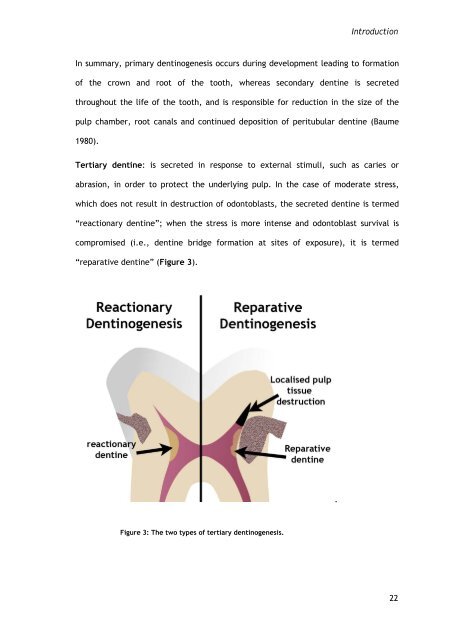- Page 1 and 2: ECOLE DOCTORALE : Génétique, Cell
- Page 3 and 4: ACKNOWLEDGEMENTS I wish to express
- Page 5 and 6: Abstract : This research aimed to i
- Page 7 and 8: CONTENTS List of Figures ………
- Page 9 and 10: 4.5.2 MSX2 and pulp repair ........
- Page 11 and 12: Figure 11 : Dentine bridge formatio
- Page 13 and 14: minutes. (DMP = dentine matrix prot
- Page 15 and 16: lipofectamin ® vector only (MDPC v
- Page 17 and 18: List of Tables: Table 1: Primer det
- Page 19 and 20: 1.1 Towards a biological approach I
- Page 21 and 22: Introduction odontoblast processes
- Page 23: Introduction Secondary dentine: thi
- Page 27 and 28: Introduction terms of the communica
- Page 29 and 30: Figure 5 : There is a differential
- Page 31 and 32: Introduction Movement of the dentin
- Page 33 and 34: 1.2.3.3 Consequences of new technol
- Page 35 and 36: Introduction an apical nucleus, whe
- Page 37 and 38: Introduction creates a physical bar
- Page 39 and 40: Introduction polarisation and the d
- Page 41 and 42: Introduction variations in pressure
- Page 43 and 44: Introduction also express neurogeni
- Page 45 and 46: 1.4.1 Reactionary dentinogenesis In
- Page 47 and 48: Introduction responses, including a
- Page 49 and 50: Introduction superficial cells move
- Page 51 and 52: Introduction induce dentine bridge
- Page 53 and 54: Introduction Because of its highly
- Page 55 and 56: Introduction (Hayashi 1982). At 11
- Page 57 and 58: Introduction To date, involvement o
- Page 59 and 60: Introduction In deeper cavities, wh
- Page 61 and 62: Introduction dental papilla cells.
- Page 63 and 64: 2 Materials and Methods Material an
- Page 65 and 66: Material and methods containing; 12
- Page 67 and 68: 2.1.2.3 Microarray analysis Materia
- Page 69 and 70: Material and methods 2.2 Part Two:
- Page 71 and 72: Material and methods a Modulyo free
- Page 73 and 74: Material and methods Figure 16: Pri
- Page 75 and 76:
Material and methods To date, sever
- Page 77 and 78:
Material and methods (pH=6.8) with
- Page 79 and 80:
Material and methods (P), and calci
- Page 81 and 82:
Material and methods (Sigma, la Ver
- Page 83 and 84:
Material and methods visualized by
- Page 85 and 86:
2.4.2.6 MSX2 over-expression in imm
- Page 87 and 88:
Material and methods channel. Data
- Page 89 and 90:
Results Amelogenin, IBSP, DCN, Alka
- Page 91 and 92:
Results data previously reported fo
- Page 93 and 94:
91 MAPK PATHWAY probe set GENE ID b
- Page 95 and 96:
Results Alkaline phosphatase and am
- Page 97 and 98:
Figure 24: Mouse upper incisor (A)
- Page 99 and 100:
Figure 25: Phosphorylated p38 prote
- Page 101 and 102:
3.3 MSX2 proteins and dentinogenesi
- Page 103 and 104:
Figure 29: First upper molar in +/+
- Page 105 and 106:
3.3.1.3 At 21days post natal : Resu
- Page 107 and 108:
Results expression, obtained using
- Page 109 and 110:
Figure 37: Immunohistochemical anal
- Page 111 and 112:
3.3.4 BrdU IHC Results BrdU was inj
- Page 113 and 114:
3.3.6 Quantitative RT-PCR (Q-RT-PCR
- Page 115 and 116:
Results 3.4 Design and use of a new
- Page 117 and 118:
Results Figure 46: Histology at 2 w
- Page 119 and 120:
Results cells is also characteristi
- Page 121 and 122:
4 Discussion Discussion 4.1 Regulat
- Page 123 and 124:
Discussion odontoblast secretory be
- Page 125 and 126:
Discussion 4.2 Molecular characteri
- Page 127 and 128:
Discussion al. 2004; Magloire, Coub
- Page 129 and 130:
Discussion differences. Bone cells
- Page 131 and 132:
Discussion we can conclude that the
- Page 133 and 134:
Discussion pathway is complex and i
- Page 135 and 136:
Discussion odontoblast physiologica
- Page 137 and 138:
Discussion dentinogenesis. By perfo
- Page 139 and 140:
Discussion cellular and molecular s
- Page 141 and 142:
Discussion Notably, our results are
- Page 143 and 144:
Discussion contribute to reparative
- Page 145 and 146:
Discussion other species (Abedi, To
- Page 147 and 148:
Discussion dentinogenesis, some cel
- Page 149 and 150:
Discussion morphology. It was not p
- Page 151 and 152:
5 Conclusion Discussion Research on
- Page 153 and 154:
Discussion Figure 50: 14 months pos
- Page 155 and 156:
References during normal and in vit
- Page 157 and 158:
References Faraco, I. M., Jr. and R
- Page 159 and 160:
References Kidd, E. A., A. Banerjee
- Page 161 and 162:
References antigen-expressing cells
- Page 163 and 164:
References Smith, A. J. and H. Leso
- Page 165 and 166:
References Yamashiro, T., M. Tummer
- Page 167 and 168:
References Appendix 1: Full list of
- Page 169 and 170:
probe set GENE ID baseline mean (LS
- Page 171 and 172:
probe set GENE ID baseline mean (LS
- Page 173 and 174:
probe set GENE ID baseline mean (LS
- Page 175 and 176:
probe set GENE ID baseline mean (LS
- Page 177 and 178:
probe set GENE ID baseline mean (LS
- Page 179 and 180:
probe set GENE ID baseline mean (LS
- Page 181 and 182:
probe set GENE ID baseline mean (LS
- Page 183 and 184:
probe set GENE ID baseline mean (LS
- Page 185 and 186:
probe set GENE ID baseline mean (LS
- Page 187 and 188:
probe set GENE ID baseline mean (LS
- Page 189 and 190:
probe set GENE ID baseline mean (LS
- Page 191 and 192:
Appendix 3: Molecular characterizat
- Page 193:
Appendix 5: Evaluation of a new lab
















